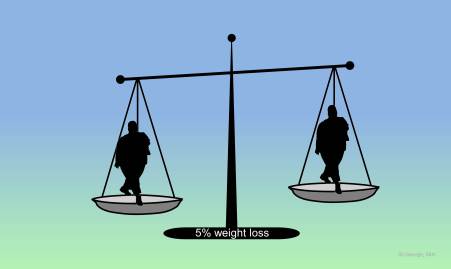Obesity Research: Study Shows Significant Benefits of Modest Weight Loss
 For the one in three American adults who are obese, recommendations to lose substantial amounts of weight through a combination of diet and exercise can seem daunting and, at times, hopeless. But a new study should come as encouraging news for all those struggling to lose the extra pounds: even a modest goal of 5 percent weight loss delivers considerable health benefits.
For the one in three American adults who are obese, recommendations to lose substantial amounts of weight through a combination of diet and exercise can seem daunting and, at times, hopeless. But a new study should come as encouraging news for all those struggling to lose the extra pounds: even a modest goal of 5 percent weight loss delivers considerable health benefits.In the NIH-funded study, people with obesity who lost just 5 percent of their body weight—about 12 pounds on average—showed improvements in several risk factors for type 2 diabetes and heart disease. They also showed metabolic improvements in many parts of the body, including the liver, pancreas, muscle, and fat tissue. While people who lost additional weight enjoyed further improvements in their health, the findings reported in the journal Cell Metabolism show that sometimes it really does pay to start small [1].
Doctors today often recommend that their patients who are obese lose 5 to 10 percent of their weight in accordance with current treatment guidelines [2]. While these guidelines are quite helpful, many individuals find that loss of 10 percent is a very difficult challenge, and it’s been unclear how much of a boost patients might receive to their metabolism and heart health by aiming for the more achievable goal of 5 percent.
To find out, Samuel Klein of Washington University School of Medicine, St. Louis, and his colleagues randomly assigned 40 obese women and men to one of two groups. In one group, participants maintained their body weight. In the other, they cut their calories and ate “self-prepared foods” to lose 5 percent, 10 percent, or 15 percent of their weight. The participants, who initially weighed about 230 pounds on average, were told not to exercise. All had signs of insulin resistance, a condition in which the body produces insulin but cells don’t respond normally to it, putting them at risk for type 2 diabetes.
Of the 20 people in the weight-loss group, all but one (who dropped out of the study) reached the initial target of 5 percent weight reduction. Nine of the remaining 19 people went on to reach the most ambitious 15 percent weight-loss goal after more than 10 months of dieting. After participants reached each of the three weight-loss targets, the researchers evaluated their heart health and metabolism, measuring their total body fat, blood pressure, heart rate, cholesterol levels, and insulin sensitivity (how well cells respond to insulin). They also looked for signs of inflammation, a possible contributor to metabolic problems, and examined the expression of genes in their fat tissue.
At 5 percent weight loss, study participants showed improved function in insulin-producing beta cells of the pancreas. They also showed increased insulin sensitivity in their liver, skeletal muscle, and fat tissue. The researchers were surprised to find that people who had lost just 5 percent of their weight showed nearly a 50 percent reduction in fat in their livers.
Those who went on to reach the 15 percent weight-loss goal continued to show improvements in the function of their pancreatic beta cells and insulin sensitivity. The researchers also observed progressive changes over the course of the study in gene expression within fat tissue, suggesting that this critical metabolic tissue is particularly responsive to weight loss.
The new findings are just the beginning of studies by Klein’s team to explore in great molecular detail why weight loss is so good for us and obesity can be so detrimental. They’d also like to examine the effects of weight loss in people with type 2 diabetes and in those following particular dietary interventions, such as a low-fat versus a low-carbohydrate diet.
These studies will yield a lot of interesting data in the years ahead. In the meantime, let’s hope these new findings will inspire those struggling with obesity to take steps, however small, toward a healthier weight.
References:
[1] Effects of Moderate and Subsequent Progressive Weight Loss on Metabolic Function and Adipose Tissue Biology in Humans with Obesity. Magkos F, Fraterrigo G, Yoshino J, Luecking L, Kirbach K, Kelly SC, de las Fuentes L, He S, Okunade AL, Patterson BW, Klein S. Cell Metabolism. 2016 April 12; 23:1-11.
[2] 2013 AHA/ACC/TOS guideline for the management of overweight and obesity in adults: a report of the American College of Cardiology/American Heart Association Task Force on Practice Guidelines and The Obesity Society. Jensen MD, Ryan DH, Apovian CM, Ard JD, Comuzzie AG, Donato KA, Hu FB, Hubbard VS, Jakicic JM, Kushner RF, Loria CM, Millen BE, Nonas CA, Pi-Sunyer FX, Stevens J, Stevens VJ, Wadden TA, Wolfe BM, Yanovski SZ; American College of Cardiology/American Heart Association Task Force on Practice Guidelines; Obesity Society. J Am Coll Cardiol. 2014 Jul 1;63(25 Pt B):2985-3023.
Links:
Choosing a Safe and Successful Weight-loss Program (National Institute of Diabetes and Digestive and Kidney Diseases/NIH)
Washington University Center for Human Nutrition (St. Louis)
NIH Support: National Institute of Diabetes and Digestive and Kidney Diseases; National Center for Advancing Translational Sciences






















.png)











No hay comentarios:
Publicar un comentario